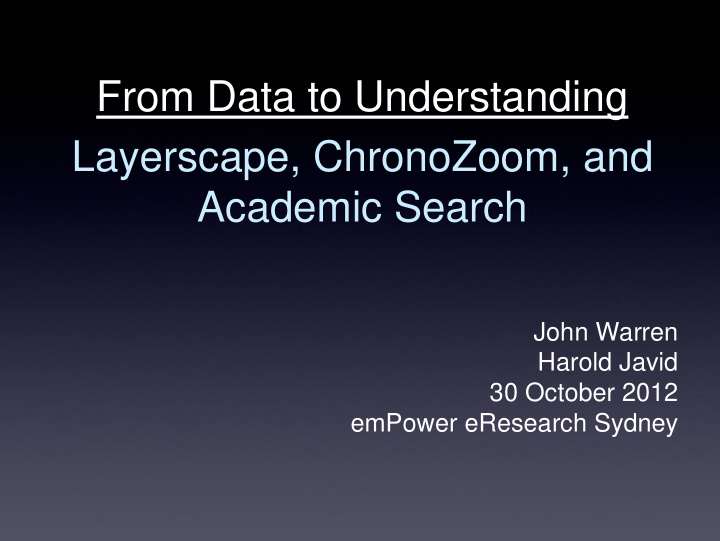



From Data to Understanding Layerscape, ChronoZoom, and Academic Search John Warren Harold Javid 30 October 2012 emPower eResearch Sydney
MSR at a glance . . . John Warren
Microsoft Research Microsoft Research mission statement: – Expand the state of the art in each of the areas in which we do research – Rapidly transfer innovative technologies into Microsoft products – Ensure that Microsoft products have a future
Product transfer examples from MSR to MS products SP2 7 8 CRM 1.0
Microsoft Research | Connections Outreach. Collaboration. Innovation. • • • • http://research.microsoft.com/collaboration/
Microsoft Research in Australia … at a glance
MSR Australia Academic Collaboration Summary 2004 - 2012 Advance the State of the Accelerate Discovery & Inspire Computer Scientists Art Exploration • Faculty Summits • >110 faculty have • RFPs & ARC Linkage Projects • Academic Search @ attended University of Melbourne • Themes • • NLP • Azure in curriculum at • Health & Wellbeing University of Queensland • Earth, Energy and • “What’s new in NUI” Environment workshops • Cloud computing • Natural User Interface • PhD School sponsorship • “Open Data for Open Science” workshops • eResearch Centre (QUT) • eScience Faculty Fellow Program Project at UQ – Prof Jane Hunter Multi million $ Research Investment
Layerscape
A cloud-based user experience Layerscape • Employs tools to analyze and visualize complex Earth and oceanic datasets. • Enables scientists to gain environmental insights. • Makes creation and sharing 3-D virtual tours and collaboration with the Earth-science community easy.
WorldWide Telescope Layerscape Application • WWT with Excel Add-in enables data visualization. • Spatial/temporal rendering and playback. • The 3-D environment - on , below, or above the Earth’s surface. • Time-series data support - more than 500,000 data points • Point, vector, and raster data — including map overlays, shape files, Microsoft Excel spreadsheets, CSV, • Story-authoring tools
Cloud based community • Share data, visualizations, stories, and related files (such as images, shape files, and maps) • Participate in existing communities (Astronomy, Oceanography, Climate, and more) Create your own community, based, for example, on your organization or area of research. • Participate in discussions: ask questions; share hypotheses; even copy, edit, and re-publish content to reflect your own perspective, expertise, and ideas. • Publish WorldWide Telescope visualizations, stories, data, and metadata. • Credit data sources; publish and receive credit for work with evolving citation tools. www.layerscape.org
Origins (not the universe but related) • All started with Big History • Conveying the vastness of time • 13.7 billion years ago until today • Hard to grasp without data visualization
Video
Need • Easier way to consume information - scientific humanistic • Beyond word search - interactive visualization. • Cross disciplinary collaboration – an environment at the crossroads of humanities and science • Interest to everyone - suited to way K-12 like to learn.
Experts
Demo
Questions
Recommend
More recommend